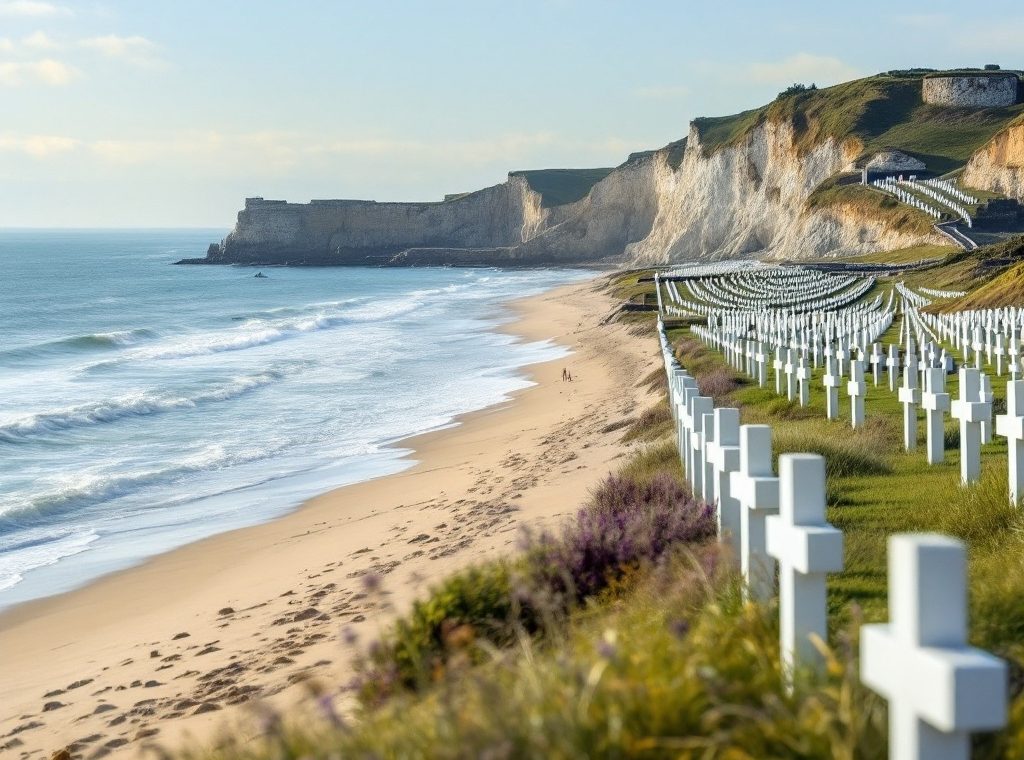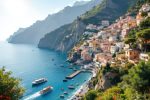A Paris to Normandy Day Trip for History Enthusiasts: Key Sites
Step back in time and witness history come alive with a captivating Normandy D-Day tour from Paris. Explore the iconic beaches of Omaha and Utah, where Allied forces bravely landed on June 6, 1944, forever changing the course of World War II. Walk among the poignant rows of white crosses at the Normandy American Cemetery and Memorial, a sobering reminder of the sacrifices made. From the dramatic cliffs of Pointe du Hoc to the remnants of the Mulberry harbor at Arromanches, our expert-led small group tours offer an intimate and unforgettable experience. Embark on this essential journey for any history enthusiast and gain a deeper understanding of this pivotal moment in world history. Book your Normandy day trip today!
Important information

- Normandy offers a profound D-Day and WWII experience, focusing on the invasion’s impact and sacrifices made.
- Key sites include Omaha Beach, Utah Beach, and the Normandy American Cemetery and Memorial.
- Day trips from Paris are typically 12-14 hours long, including 2-3 hours of travel each way.
- Small group tours with local experts offer a more in-depth and personalized experience.
- Visiting around June 6th allows participation in D-Day anniversary events and commemorations.
What Makes a Normandy Day Trip from Paris Essential for History Enthusiasts?
A Normandy day trip from Paris is essential for history enthusiasts, offering a profound D-Day and World War II experience. Visiting the impactful beaches, memorials, and museums provides tangible connections to the invasion’s significance, deepening your understanding of its scale and the sacrifices made. Key sites like Omaha and Utah Beaches, along with the Normandy American Cemetery and Memorial, foster a personal, emotional connection with history, offering deeper insight into World War II’s pivotal events. Consider these key locations for your Normandy day trip:
- Omaha Beach: Witness the site of the deadliest D-Day landing, and reflect on the immense bravery displayed there.
- Utah Beach: Explore the beach where American troops landed with relatively fewer casualties, and discover its strategic importance.
- Normandy American Cemetery and Memorial: Pay respects at the poignant resting place of thousands of American soldiers, a sobering reminder of the war’s cost.
Understanding the Significance of D-Day
D-Day, June 6, 1944, marked the Allied invasion of Normandy, a pivotal moment in the liberation of Western Europe from Nazi occupation. This daring operation, requiring meticulous planning and precise execution, saw thousands of Allied troops storm five beaches: Utah, Omaha, Gold, Juno, and Sword. Despite fierce fighting, the Allies secured a foothold, transforming these beaches into hallowed memorials to the immense sacrifices made. The Normandy landings dramatically altered the course of World War II, bringing victory significantly closer.
Exploring World War II Historical Sites
Normandy’s beaches, such as Omaha and Pointe du Hoc, offer powerful reminders of World War II’s D-Day. These sites reveal the immense sacrifices made during the invasion and provide profound insight into the war’s historical impact. Visiting them is a truly moving experience, deepening one’s understanding of this pivotal moment.
Key Sites to Visit on a Paris to Normandy Day Trip
Omaha Beach witnessed intense combat on D-Day, resulting in heavy casualties due to the challenging terrain. Today, memorials and museums stand as tributes to the brave soldiers who fought there.
At Pointe du Hoc, US Rangers bravely scaled the cliffs under heavy fire to neutralize the crucial German artillery battery. The preserved fortifications now offer stunning views, serving as a stark reminder of their courageous mission.
Sainte-Mère-Église, one of the first liberated towns, holds a unique place in D-Day history. The image of a paratrooper caught on the church steeple became an enduring symbol, and the Airborne Museum further details the airborne operations.
Utah Beach, the westernmost landing point, saw comparatively less resistance than Omaha. The Utah Beach Museum chronicles the events of that pivotal day.
Overlooking Omaha Beach, the Normandy American Cemetery is a solemn tribute to the thousands of American soldiers laid to rest there. Rows of white crosses and Stars of David mark their graves, alongside a chapel and visitor center.
Arromanches remains renowned for its Mulberry harbor, a vital artificial port constructed for D-Day. The remnants of this crucial supply line for Allied troops are still visible, and the Arromanches D-Day Museum explains its significance.
Omaha Beach: A Pivotal Landing Site
Omaha Beach, a crucial D-Day landing site, witnessed the arrival of American forces on June 6, 1944. They encountered intense German resistance. Today, this beach stands as a memorial, honoring the soldiers who fought and perished. The American Cemetery there serves as a poignant reminder of their sacrifice. Over 9,000 American soldiers are laid to rest there, having given their lives during the invasion.
Exploring Utah Beach: Another Key Landing Site
Utah Beach was a pivotal landing point for Allied forces during the D-Day invasion of Normandy, securing a decisive victory.
Pointe du Hoc: Strategic Military Importance
Pointe du Hoc, overlooking Omaha and Utah Beaches, housed German artillery that posed a significant threat to the Allied landings. On D-Day, U.S. Army Rangers scaled the cliffs under heavy enemy fire to neutralize these guns. This daring mission was critical to the success of the Normandy invasion, ultimately proving a turning point in the battle.
The Normandy American Cemetery: Honoring the Fallen
Overlooking Omaha Beach, the Normandy American Cemetery in Colleville-sur-Mer stands as a powerful tribute to 9,386 American soldiers who died during the Normandy landings and subsequent operations. Rows of white marble crosses and Stars of David mark their graves. The visitor center provides further insight with educational exhibits about the D-Day invasion. It’s a place for remembrance and reflection.
Visiting Sainte-Mère-Église: A Pivotal D-Day Location
Sainte-Mère-Église became a pivotal location during the D-Day invasion on June 6, 1944. American paratroopers landed in the town square and surrounding fields, their descent marked by the looming steeple of the town church. This church became an unforgettable landmark when paratrooper John Steele famously became entangled on its steeple. The town’s liberation marked a significant victory, as it was among the first liberated by the Allies. Its strategic location as a crossroads proved crucial for the Allied advance inland.
Discovering the Harbor at Arromanches
Arromanches played a crucial role in D-Day as the site of a Mulberry harbor. These ingenious portable structures were vital for offloading cargo directly onto the beaches. The harbor’s remnants are still visible today, offering a poignant reminder of the invasion. To delve deeper into this history, visit the Arromanches D-Day Museum, which details the harbor’s construction and its significance to the operation’s success.
What to Expect on a Guided Tour from Paris to Normandy
Normandy day trips from Paris typically last 12-14 hours, starting around 7:00 AM and returning around 9:00 PM, allowing you to maximize your time exploring this historic region. For a more personalized experience, consider a small group tour (typically 8-12 people), which fosters closer interaction with your guide and fellow travelers. Led by local experts, these tours offer valuable insights and in-depth knowledge, enriching your understanding of Normandy’s historical significance.
Duration and Schedule of the Tour
A day trip from Paris to Normandy is a long but rewarding journey, typically lasting about 13 hours. Starting before 7:00 a.m., these tours maximize your time at key historical sites. You’ll walk the sands of Omaha and Utah Beaches, and explore the dramatic cliffs of Pointe du Hoc. The solemn Normandy American Cemetery is a poignant must-see. Sainte-Mère-Église and Arromanches offer further insights into this pivotal moment in history. Here’s what you can expect:
Early Start: Tours depart Paris early in the morning, usually before 7:00 a.m., to make the most of the day.
Beach Landings: Walk the historic sands of Omaha and Utah Beaches, where Allied forces landed on D-Day.
Pointe du Hoc: Explore the dramatic cliffs of Pointe du Hoc, a strategically important German battery stormed by US Rangers.
Normandy American Cemetery: Pay respects at the Normandy American Cemetery and Memorial, a moving tribute to the fallen soldiers.
Sainte-Mère-Église and Arromanches: Visit key locations like Sainte-Mère-Église, famous for the paratrooper caught on the church spire, and Arromanches, site of the artificial Mulberry harbor.
Benefits of a Small Group Excursion
Experience the captivating region of Normandy on a personalized small group tour. With a maximum of eight guests, our expert guides provide individual attention, encouraging connections and engaging conversations with your fellow travelers. Immerse yourself in the rich history and culture of this enchanting region.
Guidance by a Local Expert
Local experts enrich the D-Day tour, sharing their deep knowledge of June 6, 1944, and adding historical context to the experience. They explain the significance of this pivotal event and discuss World War II’s impact on Normandy, offering valuable insights that truly bring history to life.
Additional Tips for Enhancing Your Normandy Day Trip
To fully experience Normandy’s D-Day history, consider visiting around June 6th, the anniversary of the landings. This week offers special events and commemorations. Departing Paris early allows you to maximize your time at the numerous historical sites. However, the 2–3 hour drive each way should be factored into your plans.
Timing Your Visit: Departure and Duration
Embark on a comprehensive Normandy history tour, beginning bright and early. This ensures ample time at each location, allowing you to fully grasp their significance.
Participating in Normandy D-Day Festivals
Normandy’s D-Day festivals offer a powerful tribute, commemorating a pivotal moment in World War II history. Attending these enlightening events provides a deeper understanding of the invasion’s impact and the sacrifices made to liberate Europe. The bravery and dedication of those involved becomes strikingly clear, fostering a personal connection with this historical turning point.













